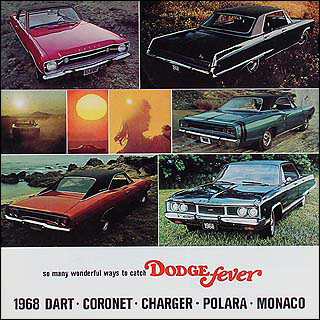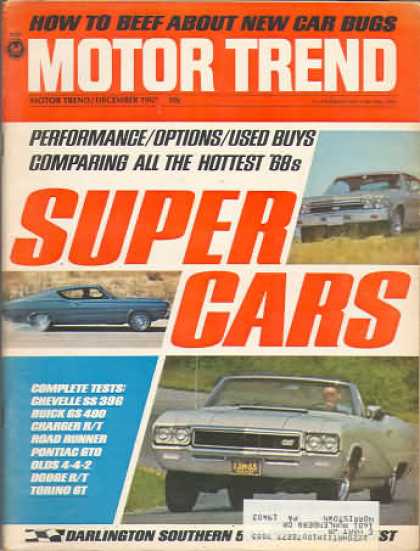|
|
|
#11 |
|
VIP Member
Join Date: Apr 2009
Posts: 2,546
Likes: 0
Liked 10 Times in 10 Posts
|
December 1967
High Performance Car Magazine Taking a looking at the 'new' 1968 Charger 383 (4-Speed) compared to last year's 1967 Charger 383 (4-Speed). Article; 'Did We Miss Something At The '1967' Dodge Rebellion, And Did We Now Catch '1968' Dodge Fever. Part 1 '1967' 383/325 HP 4-Barrel 325 Horsepower @ 4800 RPM 425 Foot Pounds of Torque @ 2800 RPM 10.00 to 1 Compression Ratio Performance.................15.92 @ 86.7 MPH '1968' 383/330 HP 4-Barrel 330 Horsepower @ 5000 RPM 425 Foot Pounds of Torque @ 3200 RPM 10.00 to 1 Compression Ratio Performance.................15.15 @ 92.1 MPH We asked, where did the nearly (-.77) quicker times come from, despite only a (+5) Horsepower increase in engine output. Is the 1968 383/330 HP engine underrated, or is the 1967 383/325 HP grossly overrated. Or, is Chrysler completely 'off-the-charts' in listing the Advertised Horsepower rating of the 383 4-Barrel at '330' in the 'new' 1968 Dodge Charger 383. Both cars have the near identical shipping weight - (1967 Charger '383' #3650 lbs.) and the (1968 Charger '383' #3653 lbs.) High Performance Car will take a look at the major differnences; For 1968, the 383 Engine has a different rotating assembly, though the bore and stroke sizes are identical. The 1968 engine has a Piston positive deck height of (+.014), while the older 383 has a (-.007) below deck Piston height. The 1968 Cylinder Heads (Casting #2843906) are Open-Chamber style, with a 79.5 CC combustion chamber volume, while the older 383 uses the (Casting #2406516) Closed-Chamber style with a smaller 73.5 CC combustion chamber volume. The difference in Cylinder Head and Piston Deck makes no change in either 383 Compression Ratio of 10.00 to 1. Chrysler has stated that the 'Open-Chamber' design will improve cylinder volume flow, and that the new #2843906 casting will increase CFM flow, due to improvements in the port design. ------------------------------------------------------------------------------------------------------------------------------------------------------------------ Both Cylinder Heads utilize the 2.08" 'big-valve' Intake, but the 'new' 1968 Cylinder Heads have 10% larger Intake Ports, which now have a radius-type design instead of the older 'flat-floor' intake port shape. The new 383 Cylinder Head now utilizes a 1.74" Exhaust Valve, while the 1967 and earlier 383 Cylinder Heads carry a 'small-valve' 1.60" Exhaust. The bigger exhaust valve, larger throat area opening, and improvements in the exhaust port design (less restrictive bends) increases exhaust flow by 18%. ------------------------------------------------------------------------------------------------------------------------------------------------------------------------ Both the 1967 383 and 1968 383 utilize the same Valve-Train. The Camshaft unit has a lift of .425 Intake and .437 Exhaust, with a Duration of 256* Intake and 260* Exhaust, and with an Overlap of 32* Valve Springs remain the same, with a load rating of #134 lbs. with the Valve Closed, and #208 lbs. with the Valve Open. ------------------------------------------------------------------------------------------------------------------------------------------------------------------------- A big difference was found in the cast iron Dual-Plane Intake Manifold. The 1967 unit (Casting #2205968) which has been a major complaint with 383 performance-minded drivers, has been replaced with a new larger runner and improved flow cast iron Dual-Plane intake (Casting #2806301). The 1968 Intake Manifold has 10% 'greater' Branch sizes, and a 50% increase in Runner-sizes. Also, the carburetor mounting bore sizes have been increased from the 1 7/16" (Primary) and 1 9/16" (Secondary) on the 1967 Intake Manifold, to an equal 1 11/16" (Square-Bore size) on the 'new' 1968 Intake Manifold. The incease in 'branch and runner' sizes, and larger sized throttle bore openings will provide for a significant improvement in performance at the higher RPM levels. Last edited by Paul Ceasrine; 02-18-2013 at 12:59 PM. |
|
|

|
|
|
#12 |
|
VIP Member
Join Date: Apr 2009
Posts: 2,546
Likes: 0
Liked 10 Times in 10 Posts
|
'Did We Miss Something At The '1967' Dodge Rebellion, And Did We Now Catch '1968' Dodge Fever'
Part 2 The 1968 Charger 383 Carburetor is a new design Carter AVS, that carries an 'advertised' CFM rating of 625, (true rating of 637 CFM's). This vacuum secondary operated Carburetor has 1 7/16" Primary Throttle-body openings, but has larger 1 11/16" Secondaries for increased air/gas flow mixture. The 1967 Charger 383 is equipped with the sometimes 'pesky' Carter AFB, which carries a 575 CFM rating. This carburetor also utilizes a 1 7/16" Primary, but has a smaller 1 9/16" Secondary Throttle-body opening.The 'mechanical' secondaries can be problematic at times, letting the mixture get 'too lean'. The new' Carter AVS (Air-Valve Secondary) utilizes an 'air-valve' for the secondaries. As the throttle is opened, air-vacuum slowly pulls down on the secondary throttle plates. This way, the mixture is kept from getting 'too lean'. This also improves the all important 'Venturi-Effect'. ------------------------------------------------------------------------------------------------------------------------------------------------------------------- There is no change from the 1967 Charger 383 Dual-Snorkel and the 'new' 1968 Charger 383 Dual-Snorkel Air Cleaner. ------------------------------------------------------------------------------------------------------------------------------------------------------------------ Ignition remains the same with always reliable Single-Point Distributor with a Vacuum-advanced unit. ------------------------------------------------------------------------------------------------------------------------------------------------------------------ Last edited by Paul Ceasrine; 02-18-2013 at 09:22 AM. |
|
|

|
|
|
#13 |
|
VIP Member
Join Date: Apr 2009
Posts: 2,546
Likes: 0
Liked 10 Times in 10 Posts
|
'Did We Miss Something At The '1967' Dodge Rebellion, And Did We Now Catch '1968 Dodge Fever'
Part 3 It is obvious that there is a significant difference in the 'driver-side' Exhaust Manifold unit.. The 1967 Charger 383 utilized a standard unit (Casting #2532626) which is the same manifold found on the 'intermediate' 383 2-Barrel 'non-performance' engines. These are somewhat restrictve units, that do effect exhaust flow from the left side engine bank. The 1968 Charger 383 now has a 'new design' High-Perfomance exhaust manifold (Casting # 2843992) with extended header-type passages that have a wind-swept flow design which deliver an improvement in exhaust flow, which unleashes an increase in horsepower gain from the left side engine bank. Both exhaust manifolds have a 2.25" flange exit opening, but the 'new' 1968 unit has a more efficient header exit passage, with a less restrictive bend, resulting in an increase of nearly 40% more exhaust flow. ----------------------------------------------------------------------------------------------------------------------------------------------------------------------- Both the 1967 Charger 383 and 1968 Charger 383 utilize the 'same' Passenger-side exhaust manifold (Casting #2532464). The Exhaust System piping is the same size for both Models. The primary piping carries a 2.25" diameter to each 'low-restriction flow muffler'. The tail-pipe leaves the muffler with a 2.25" size, but is tapered down to a 2.00" diameter as it crosses over the rear-axle, and then ends with a 1.88" tail-opening. But, in the 1968 Charger 383, if you order the 'Exterior Decor Package', the tail-pipe leaves the muffler with a 2.25" size, and is also tapered down to 2.00" diameter as it crosses over the rear-axle. But the 2.25" diameter is returned to the pipe as it exits to the end with a 2.25" opening for the Chrome-Tipped extension. Last edited by Paul Ceasrine; 02-18-2013 at 11:53 AM. |
|
|

|
|
|
#14 |
|
VIP Member
Join Date: Apr 2009
Posts: 2,546
Likes: 0
Liked 10 Times in 10 Posts
|
'Did We Miss Something At The '1967 Dodge Rebellion, And Did We Now Catch '1968' Dodge Fever'
Part 4 There is a difference in the Engine Fan assembly. The 1967 Charger uses a 'standard' 17" 4-Blade Fan, mounted directly to the Water Pump drive. The 'new' 1968 Charger 383 uses an 18" 7-Blade Fan, with the addition of a Fan-Clutch (Part #2863216). The 7-Blade Fan provides addittional cooling, and the Fan-Clutch reduces drag on the Engine, which helps prevent Horsepower 'loss', resulting in a saving of (5 to 7 Horsepower). --------------------------------------------------------------------------------------------------------------------------------------------- We found no other mechanical differences between the 1967 Charger 383, and the 1968 Charger 383, as the transmissions, clutches and shifters are identical. The only other item, was that the 1967 Charger does come through with the Tachometer as 'standard equipment', while this is an 'option' on the 1968 Charger. Last edited by Paul Ceasrine; 02-19-2013 at 01:44 PM. |
|
|

|
|
|
#15 |
|
VIP Member
Join Date: Apr 2009
Posts: 2,546
Likes: 0
Liked 10 Times in 10 Posts
|
High Performance Car Magazine
Final Comparison Analysis Beteen the 1967 Charger '383' and the 1968 Charger '383'. The results are not even close. The 1968 Charger out-performs the 1967 Charger in a match-up of Drag Strip Performance. Though each car weighs the same and have equal drive-trains, the 1968 '383 Engine surpasses the 1967 '383' Engine hands-down. At the Drag Strip, the 1968 power-plant showed nearly 8/10's quicker Elapsed Times with our 4-Speed Car Tests. And Top Speed resulted in a 5.4 MPH gain. Based upon Chrysler's current 330 Horsepower Rating of the 1968 383 4-Barrel, we feel that this power-plant puts out nearly {+40} more Horsepower than the 1967 383 4-Barrel Engine. Horsepower Gains for the 1968 Charger '383' over the 1967 Charger '383 * Cylinder Heads............+ 15 HP * Intake Manifold............. + 8 HP * Carburetor.................... + 6 HP * Exhaust Manifold.......... +7 HP * Fan-Clutch.................... + 5 HP  1968 Mid-Year Improvements * A 'new' Unsilenced Air-Cleaner * Switching from the Inland 4-Speed Shifter to a Hurst 4-Speed unit with improved linkage. High Performance Car Magazine (overview) * Limited Production of 4-Speed Charger '383' cars * No options for suspension or handling packages * 3.23 Open-Rear as 'standard equipment' * 3.55 Gears as only optional gear-ratio available * No Horsepower-upgrade option for the 383/330 HP 'H-Code' engine Though we appreciate Dodge in their efforts to deliver a Gentleman's Musclecar with a 'new' potent 383 4-Barrel big block engine, we have a few suggestions. 1) Offer an option for the Charger 383 with an 'S-16' Heavy-Duty Suspension/Handling Package, which would include; A) Heavy-Duty .92 torsion bars, B) Heavy-Duty Front Shocks, C) Heavy-Duty Leaf Springs, D) Rallye Wheels, E) F-70 x 14" tires, F) 11" Drum Brakes and G) 3.55 Gears with Sure-Grip Rear. This could be called the 383 'S-16', with exterior badging on the front fenders and trunk lid rear panel. Last edited by Paul Ceasrine; 02-19-2013 at 08:10 PM. |
|
|

|
|
|
#16 |
|
VIP Member
Join Date: Apr 2009
Posts: 2,546
Likes: 0
Liked 10 Times in 10 Posts
|
1968 Dodge Charger R/T (Not the Charger 383)
Dodge Charger R/T, with the 440/375 HP, called the '440 Magnum' Shipping Weight....#3737 Lbs. ~ 375 HP = 9.96 Wt/Hp 1968 NHRA Class Stock......................D/S or D/SA Super/Stock..........SS/F or SS/FA Production Numbers.....17,584 * Automatics...................14,366 * 4-Speed..........................3218 The R/T was equipped with 'Suspension upgrades' * Drum Brakes...... 11" x 3.00" (Front) and 11" x 2.5" (Back) * Torsion bars........ .92 * Front Sway-Bar... .94 * Special Heavy-Duty Front Shocks (Code - #S02) * Heavy Duty Leaf Springs - 6-Leaf (Left) and 5.5 Leaf (Right) * 26" Radiator (Code A1) * 'Scat-Pack' Bumble Bee Stripes Last edited by Paul Ceasrine; 02-19-2013 at 08:09 PM. |
|
|

|
|
|
#17 |
|
VIP Member
Join Date: Apr 2009
Posts: 2,546
Likes: 0
Liked 10 Times in 10 Posts
|
1968 Dodge Charger R/T '440 Magnum'
375 Horsepower @ 4600 RPM's 480 Foot Pounds of Torque @ 3200 RPM's * 4-Speed - w/3.54 Dana.................... 14.40 @ 96.8 MPH * Automatic - w/3.23 Sure Grip........... 14.87 @ 94.3 MPH * Automatic - w/3.55 Sure-Grip........... 14.53 @ 95.5 MPH The 440/375 HP featured 2.50" exhaust pipes, with 2.25" tail-pipes, and a 2.25" 'H-Pipe'. While the Automatic Transmission in the 383 carried a 2300 RPM Stall Torque-Converter, the R/T '440 Magnum' utilized a 2000 RPM Torque-Converter. The '440 Magnum' was also equipped with a heavier-rated 727-B Torque-Flite which had an additional Pinion {8-Pinions in total}, and a larger Output-Shaft. While both Mopar 440 and 383 Big-Blocks were equipped with 11" Clutch Units in the A-833 4-Speed, the '440 Magnum' had the heavier-rated Clutch-Disc and Pressure-Plate. Last edited by Paul Ceasrine; 02-22-2013 at 03:05 PM. |
|
|

|
|
|
#18 |
|
VIP Member
Join Date: Apr 2009
Posts: 2,546
Likes: 0
Liked 10 Times in 10 Posts
|
Last edited by Paul Ceasrine; 02-19-2013 at 07:47 PM. |
|
|

|
|
|
#19 |
|
VIP Member
Join Date: Apr 2009
Posts: 2,546
Likes: 0
Liked 10 Times in 10 Posts
|
1968 Advertisement
Let Boch Dodge Turn Your 383 4-Barrel Into A 383 'Magnum HP' With Our Dealer Only Engine Performance Kit. For $383 you can turn your 383 into a 'Magnum HP' Our Performance Parts Department can offer you an 'over-the-counter' 'Magnum HP Kit', which will add over 50 Horsepower to your 383 Big-Block giving you an output of 383 Horsepower. Performance Kit includes, * 383 'Magnum HP' Camshaft * 440 Valve Springs * Special Intake Carburetor Adapter * Holley 780 CFM Carburetor * Unsilenced Air-Cleaner * Distributor Advance-Kit * Cyclone Headers * High Pressure Fuel Pump 383 'Magnum HP' Camshaft (Hydraulic) Lift...............450/.465 Duration..... 276*/292* Overlap...... 54* This Camshaft is more aggessive than the 440 HP Camshaft. Last edited by Paul Ceasrine; 02-20-2013 at 10:07 AM. |
|
|

|
|
|
#20 |
|
VIP Member
Join Date: Apr 2009
Posts: 2,546
Likes: 0
Liked 10 Times in 10 Posts
|
Motor Trend (December 1967)
Road Test, 1968 Dodge Charger R/T ('440 Magnum' - w/Automatic and 3.23 Sure-Grip) Performance.......14.90 @ 95.5 MPH * Respectable, despite absolutely no traction with the F70 x14" tires. 
|
|
|

|
 |
«
Previous Thread
|
Next Thread
»
|
|
All times are GMT -4. The time now is 12:43 PM.





























 Linear Mode
Linear Mode

